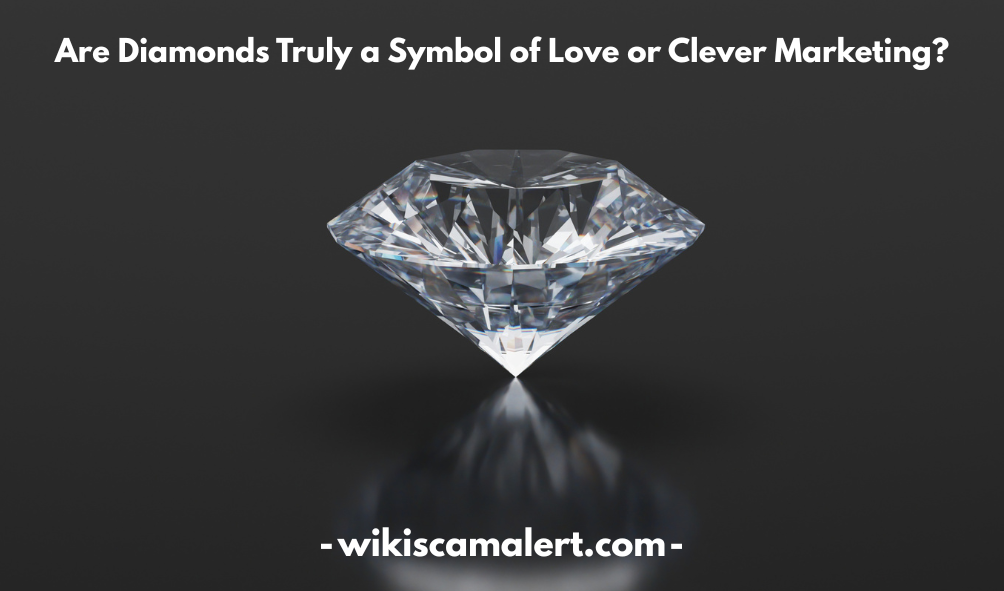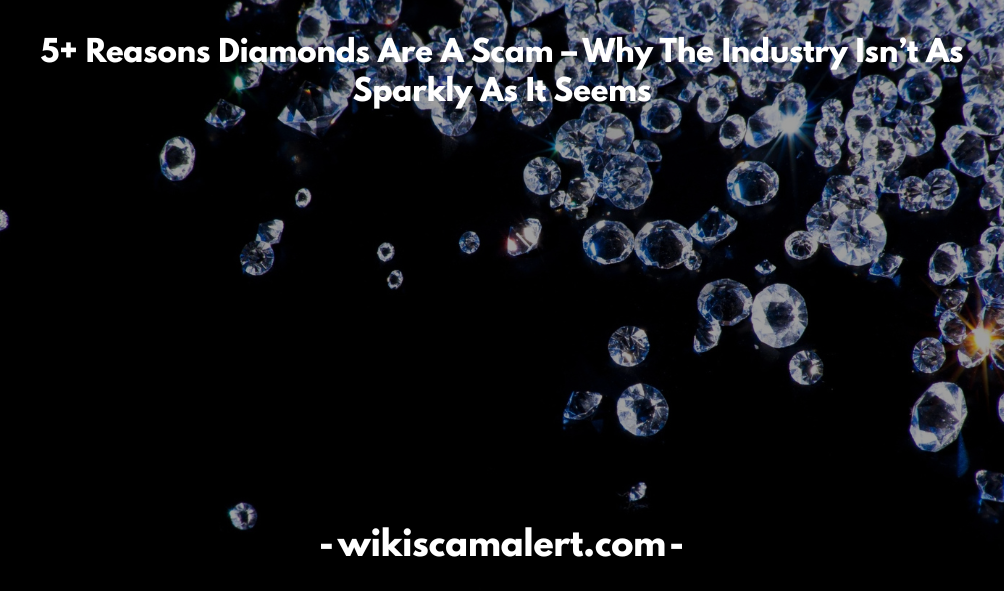Let’s be real for a second—how many of us have grown up believing that diamonds are the ultimate symbol of love, success, and forever? Those shiny little stones have worked their way into our proposals, weddings, red carpet events, and even rap lyrics. But here’s the thing that might rock your world a bit… phrase “diamonds are a scam” Why The Industry Isn’t As Sparkly As It Seems is more than clickbait — it reflects a complex manipulation by corporate powers like De Beers, who orchestrated a global strategy to control supply, demand, and consumer sentiment.
Exposing the Diamond Deception
The idea that diamonds are “precious” and inherently valuable is a carefully crafted illusion. Most people don’t realize that their sparkling engagement ring is the product of a decades-long marketing campaign — not natural rarity or intrinsic worth. The phrase “diamonds are a scam” is more than clickbait — it reflects a complex manipulation by corporate powers like De Beers, who orchestrated a global strategy to control supply, demand, and consumer sentiment.
This deception thrives on three core tactics:
- Artificial Scarcity: Even though diamonds are abundant, suppliers limit how many hit the market. This gives the false impression that diamonds are rare.
- Emotional Marketing: Campaigns like “A Diamond is Forever” equated diamonds with eternal love. Suddenly, buying a rock became a requirement for proposing.
- Social Pressure: Society latched on. Now, not buying a diamond can feel like you’re being cheap or unromantic.
The reality is, diamonds have little resale value. Try pawning a diamond ring and see what happens. Most jewelers will offer a fraction of what you paid — because the resale market is nearly nonexistent. The moment you walk out of the store, that diamond loses 30–70% of its retail value.
So what’s the deception? It’s selling a product with no functional utility, no lasting financial value, and no natural scarcity — as if it’s the most essential luxury you can buy. That, my friend, is a scam.
How the Diamond Industry Fabricated Demand
The modern demand for diamonds didn’t evolve naturally. It was manufactured — and De Beers, a South African diamond company, was the mastermind behind it. In the early 1900s, they controlled over 90% of the global diamond supply. But there was one problem: no one really wanted diamonds.
To fix that, they launched one of the most aggressive and successful advertising campaigns in history. Here’s how they did it:
- 1938 De Beers Ad Campaign: Partnered with N.W. Ayer advertising agency, they promoted the message that “a diamond is a symbol of love.” They used Hollywood stars and royalty to model diamond rings, embedding the idea that diamonds were essential.
- “A Diamond Is Forever” (1947): Possibly the most iconic slogan ever written. It told people that love must be marked with a diamond — and not just any diamond, but one worth two months’ salary. The result? A near-instant cultural tradition.
- Educating the Public Through Media: De Beers funded school textbooks, wedding magazines, and even scripts in romance movies to reinforce the idea that a diamond engagement ring was a non-negotiable tradition.
- Market Control: De Beers also hoarded diamonds in vaults, releasing them slowly to keep prices high — controlling both supply and perception.
By the 1980s, over 80% of American engagements involved a diamond ring — a complete 180 from pre-1940s culture. That’s not organic demand. That’s manufactured desire, cleverly disguised as romantic tradition.
Understanding Why Diamonds Are a Scam
So, why are diamonds a scam? It comes down to one thing: you’re paying luxury prices for a product with artificially inflated value, mass availability, and limited resale utility.
Here’s a breakdown of the scam components:
- Artificial Rarity: Despite what jewelers claim, diamonds are not rare. The Earth produces millions of carats of diamonds annually, and labs can now create them in days. The scarcity is only perceived, not real.
- Horrible Resale Value: Unlike gold, silver, or even art, diamonds lose a shocking amount of value once purchased. This isn’t an investment — it’s a luxury tax disguised as love.
- Monopolized Pricing: De Beers and a handful of corporations continue to influence pricing, keeping it elevated far beyond the actual cost of production or rarity.
- Romantic Manipulation: Advertising campaigns embedded the belief that diamonds equate to love, commitment, and success. This psychological manipulation pressures people into spending money they don’t have on something they don’t need.
- Ethical Problems: The so-called “blood diamonds” are still a concern. Many diamonds, especially from African mines, have dark histories of labor exploitation, child workers, and funding of armed conflict — yet they’re sold to you with a glossy, innocent sparkle.
In other words, the diamond market isn’t built on natural value — it’s built on illusion, branding, and exploitation.
The Real Worth of Diamonds: Market Manipulation
Let’s talk dollars and sense. When it comes to diamonds, the actual market value is a complete joke compared to the retail price you pay. Here’s the real picture:
- Retail vs. Resale: Buy a $10,000 diamond ring from a high-end jewelry store and try reselling it the next day. You’ll be lucky to get $3,000. That’s a 70% loss — instantly.
- Inflated Retail Prices: Jewelry stores mark up diamonds by 100–200% or more. You’re not paying for the stone — you’re paying for brand, store markup, packaging, and the illusion of prestige.
- Synthetic Diamond Disruption: Lab-grown diamonds, which are chemically identical to natural ones, cost 40–70% less. This proves that production cost is low — and the price you pay is based on emotional manipulation, not value.
- Supply Control: De Beers and similar companies stockpile diamonds and slowly release them to maintain high prices. In a free market, oversupply would crash prices. But through tight distribution, they maintain artificial scarcity.
- No Intrinsic Value: Unlike gold (used in electronics, medicine, etc.), diamonds serve little industrial purpose outside of cutting tools. And yet, you’re paying as if they’re as useful and rare as gold.
The real worth of diamonds? Far less than what you’re paying. The markup is pure marketing.
The Myth of Rarity in the Diamond Trade
One of the biggest lies the industry sells is this: “Diamonds are rare.” This claim is utterly false — and here’s why:
- Geological Abundance: Diamonds are found on every continent except Antarctica. Massive deposits exist in Russia, Botswana, Canada, and Australia. They’re mined by the millions of carats each year.
- Lab-Grown Diamonds: Not only are natural diamonds abundant, but synthetic diamonds are booming. They’re identical in every way — and even more flawless. If diamonds were truly rare, you wouldn’t be able to buy a flawless lab-grown one for half the price.
- Controlled Supply, Not Low Supply: The “rarity” myth was created by restricting access. De Beers once held stockpiles of uncut diamonds worth billions, slowly releasing them to avoid market crashes.
- Rarity vs. Perceived Value: In economics, value often depends on scarcity. But if you have to create scarcity through manipulation, it’s not true rarity — it’s marketing theatre.
- Flooding the Market Quietly: Over the years, when the industry feared price drops, they quietly dumped diamonds into developing markets to maintain their dominance without crashing prices in wealthier countries.
The truth? Diamonds are about as rare as bottled water at a gas station. But the industry has built an empire by convincing you they’re as unique as your fingerprint.

Are Diamonds Truly a Symbol of Love or Clever Marketing?
For many, diamonds are considered the ultimate expression of love, commitment, and marriage. But when you dig deeper, you’ll find that this romantic symbolism wasn’t forged in ancient history — it was manufactured in a boardroom.
The roots of the “diamond = love” idea are surprisingly recent:
- The 1930s Love Drought: During the Great Depression, diamond sales plummeted. People weren’t interested in luxury. Enter De Beers, who launched a campaign to invent the idea that an engagement without a diamond ring was incomplete.
- “A Diamond is Forever” (1947): This four-word slogan, created by copywriter Frances Gerety, became one of the most influential marketing messages in history. It linked diamonds to eternity, romance, and loyalty — and changed cultural expectations forever.
- Movie Placement & Celebrity Influence: De Beers strategically placed diamonds in the hands of Hollywood actresses and in films where marriage and glamour were central themes. This embedded the gem into pop culture’s romantic narrative.
- Two Months’ Salary Rule: Not a tradition — a marketing trick. The idea that a man should spend two months’ salary on a diamond ring was created by advertisers to boost profits, not love.
So, are diamonds really a symbol of eternal love? Or is it clever psychological manipulation — a fabricated need wrapped in emotion? Real love doesn’t require a $5,000 rock. That pressure? That’s corporate romance, not real romance.
The Illusion of Investment: Why Diamonds Lose Value
Many people are led to believe that buying a diamond is like buying a house or stock — a safe, long-term investment. But this is a myth. In reality, diamonds are one of the worst “investments” you can make.
Here’s why:
- No Resale Market: Retail diamonds sell at a massive markup. Try reselling your ring at a jeweler, and you’ll discover it’s worth 30–50% less — instantly.
- Lack of Standard Pricing: Unlike gold or silver (which have spot prices), diamonds are graded by subjective metrics — cut, clarity, carat, and color. These “4 Cs” aren’t universally valued the same way, and there’s no unified secondary market.
- Liquidity Problems: You can’t easily cash out. Most pawn shops offer cents on the dollar, and selling a diamond privately is time-consuming, risky, and rarely profitable.
- Lab-Grown Disruption: The rise of lab-created diamonds is crashing the traditional market. Buyers now realize they can get the same sparkle for half the price, making your natural diamond depreciate even faster.
- Overproduction: Diamond mines continue to produce more than the market needs. To maintain high prices, companies artificially limit supply — which isn’t sustainable in the long run.
Unless you’re trading in extremely rare, colored diamonds valued by collectors, your standard engagement diamond will never appreciate. It’s not an asset — it’s a depreciating luxury item disguised as a financial move.
Lab-Grown Diamonds vs. Natural: Are Either a Scam?
With the rise of synthetic diamonds, consumers now face a new dilemma: Are lab-grown diamonds more ethical — or just another scam in disguise?
Let’s unpack both sides:
Lab-Grown Diamonds – Pros & Cons
Pros:
- Same chemical structure: They are real diamonds — identical to natural ones in composition and appearance.
- Ethically superior: No mining, no conflict zones, no blood diamonds.
- Eco-friendlier: Less destructive to ecosystems and doesn’t require child labor or warzone mining.
- Cheaper: Often 30–70% less expensive.
Cons:
- Terrible resale value: Even worse than natural diamonds. Buyers often won’t repurchase them at all.
- Not rare: Can be mass-produced, which removes any illusion of exclusivity.
- Still marketed emotionally: Sellers often copy the same manipulative marketing strategies used by natural diamond companies.
Natural Diamonds – Pros & Cons
Pros:
- Perceived prestige: Still seen as more “valuable” or “authentic” by traditionalists.
- Long-term durability: Great for heirlooms — but that’s sentimental, not financial.
Cons:
- Overpriced: Inflated prices and poor resale.
- Ethical concerns: Many still originate from mines with horrific human rights abuses.
- Greenwashing: “Conflict-free” is often unverifiable and loosely regulated.
So, are either a scam? Not in the strictest sense — they’re both real products. But the way they’re packaged, marketed, and emotionally manipulated? That’s where the scam lives. Both cater to a fabricated emotional need while ignoring economic logic.
Cremation Diamonds: Grief or Gimmick?
Cremation diamonds — turning ashes of a loved one into a diamond — are marketed as the ultimate memorial. It sounds touching… but is it science, scam, or somewhere in between?
Here’s the truth behind the sparkle:
- The Process: These diamonds are created using high-pressure, high-temperature (HPHT) synthesis. Carbon from cremated ashes is extracted and crystalized — similar to lab-grown diamonds. Technically, it’s real.
- But Here’s the Catch:
- Ashes have very little usable carbon. Most cremation services add additional carbon to “complete” the process. This means your “memorial diamond” might only contain a trace of your loved one.
- Pricing is outrageous. Cremation diamonds cost anywhere from $3,000 to $20,000 — and are often smaller or lower in clarity than retail diamonds.
- Emotional Manipulation: The grief industry thrives on people wanting meaning. Selling you a diamond as a form of closure is lucrative — but is it genuine?
- Ashes have very little usable carbon. Most cremation services add additional carbon to “complete” the process. This means your “memorial diamond” might only contain a trace of your loved one.
- Transparency Issues: How do you verify that the diamond truly contains your loved one’s ashes? Without third-party validation, you’re taking it on faith.
Cremation diamonds are not necessarily a scam, but they walk a fine line between grief-based exploitation and meaningful tribute. It’s a heavily emotional decision — and companies know that. It’s vital to ask: Are you buying comfort… or just clever salesmanship?
Herkimer Diamonds: Crystal Confusion or Con Job?
Herkimer diamonds aren’t real diamonds — and that’s exactly the issue.
Here’s what they really are: double-terminated quartz crystals found in Herkimer County, New York. They’re beautiful, clear, and naturally faceted. But they’re not carbon-based diamonds.
So why the confusion? Marketing.
- Misleading Name: The term “Herkimer diamond” makes it sound like a rare gemstone when it’s actually a type of quartz — worth a fraction of the price.
- Sold at Crystal Shops: They’re popular in metaphysical stores, often marketed as “energy amplifiers” or “chakra cleaners.” Some sellers even price them as if they’re real diamonds.
- Tourism Trap: Many “mine-your-own” attractions in New York charge people for the experience of digging up Herkimer diamonds. It’s fun — but often misrepresented as rare gemstone mining.
- Online Listings: Some shady retailers sell Herkimer quartz jewelry as “raw diamonds” to unknowing buyers.
To be clear: Herkimer diamonds are not a scam if sold transparently. They are unique and lovely quartz crystals. The scam comes in when language is manipulated to confuse customers — or when sellers intentionally misrepresent their value and identity.
Inside De Beers: The Monopoly That Shaped Our Beliefs
No single company has had more influence over global perception of diamonds than De Beers. For most of the 20th century, De Beers controlled over 80–90% of the world’s rough diamond supply. They didn’t just dominate the market — they created the illusion of value, scarcity, and romance around diamonds.
Here’s how De Beers shaped what we believe about diamonds:
- Supply Control = Price Control: De Beers stockpiled diamonds and released them in tightly controlled quantities. This artificial scarcity allowed them to inflate prices while keeping the illusion of rarity alive.
- Global Cartel Operations: They built an international syndicate, striking exclusive deals with diamond mines and buyers to funnel all supply through their channels. If a producer didn’t play by their rules, they were cut off or bought out.
- Advertising Mastery: De Beers essentially created the modern engagement ring tradition with their marketing campaigns. From the “two months’ salary rule” to romantic ads in nearly every publication, they hardwired diamonds into marriage culture.
- Aggressive Enforcement: Competitors who tried to undercut the monopoly faced lawsuits, boycotts, and blacklisting. De Beers even refused to sell to jewelers who didn’t agree to promote the message of diamond-as-eternal-love.
- Branding vs. Reality: Despite being a monopolistic cartel, De Beers always presented itself as a benevolent promoter of love and beauty — using glossy ads to hide brutal mining practices and worker exploitation behind the scenes.
Though De Beers’ dominance has waned in recent years due to antitrust lawsuits and new players in the lab-grown space, their psychological and cultural influence remains intact. Even now, they’re a textbook example of how a monopoly can shape beliefs on a global scale.
“A Diamond Is Forever”: Advertising’s Biggest Lie
When ad agency N.W. Ayer coined the phrase “A Diamond Is Forever” in 1947, they didn’t just create a tagline — they created a cultural myth. It’s considered the most successful advertising slogan of the 20th century, and it’s also one of the most deceptive.
Here’s why:
- Diamonds Are Not Eternal: While physically durable, diamonds can be chipped, damaged, or lost. Emotionally? Relationships don’t always last — yet this slogan fused the idea of permanence to an inherently flawed concept.
- The Real Goal Was Profit: The slogan was designed to discourage resale, subtly convincing people that diamonds were too sentimental to part with — keeping them off the secondary market and prices artificially high.
- Manipulated Social Norms: In the 1930s, fewer than 10% of engagement rings had diamonds. By the 1980s, it was 80%. The slogan made it socially unacceptable not to buy a diamond ring.
- Emotional Hijacking: “Forever” invokes security, romance, and timeless devotion. The campaign weaponized emotion to mask the absence of intrinsic value in diamonds.
- Still Used Today: The phrase remains embedded in movies, songs, commercials, and wedding culture. Many people still quote it — unaware it was cooked up in a boardroom to move inventory.
It’s not just a slogan. It’s a psychological anchor that tricks people into assigning deep personal meaning to an otherwise commercial product.
Why Selling a Diamond Will Shock You
If you’ve ever tried to resell a diamond, you know the truth: diamonds are great at holding memories, but terrible at holding value.
Here’s why selling your diamond is such a shocker:
- Instant Depreciation: The moment you walk out of the store, your diamond is worth 40–70% less. Why? Jewelers mark up diamonds by 100% or more. What you paid was never its true market value.
- No Standard Pricing: Unlike gold or silver, diamonds have no “spot price.” Valuation is subjective and opaque, based on the 4 Cs — and most buyers will undervalue your stone to protect their margins.
- Retailers Won’t Buy Back: Most jewelers refuse to buy back diamonds they sold unless you’re upgrading — and even then, their trade-in offers are often insultingly low.
- Pawn Shops and Resellers: If you go the pawn shop route, expect to get maybe 10–30% of the original price. Online resale platforms aren’t much better — it’s difficult to find a buyer who will pay fair market value.
- Lab-Grown Disruption: With lab-grown diamonds flooding the market, the price of natural stones is dropping even faster, and buyers know this. Reselling a “real” diamond today is like trying to offload outdated tech.
- Sentiment ≠ Value: What your diamond means to you doesn’t affect what it’s worth to others. The resale market is brutally indifferent to your wedding memories.
Diamonds are often bought as if they’re timeless assets — but they behave more like used cars. Once it’s yours, it’s worth far less to anyone else.
Can Lab Diamonds Be Trusted or Are They Another Trap?
Lab-grown diamonds are marketed as the ethical, affordable alternative to natural diamonds. But as their popularity grows, so do the questions: Can they be trusted? Or are they just a modern twist on the same manipulative sales playbook?
Here’s the full breakdown:
What’s Great About Lab Diamonds:
- Chemically Identical: They’re real diamonds. Not simulants like cubic zirconia. Same structure, same sparkle.
- Ethically Cleaner: No war-torn mines. No child labor. No “blood diamonds.”
- Eco-Alternative: Mining is brutal on the environment. Lab creation uses less land and causes far less ecological destruction.
- Cost-Effective: Typically 30–70% cheaper than natural diamonds for the same size and quality.
Where the Trap Lies:
- No Resale Value: If natural diamonds are bad investments, lab diamonds are worse. Most resellers won’t touch them. They’re seen as mass-produced, easily replaceable, and disposable.
- Artificial Scarcity All Over Again: Some companies are already trying to hype lab diamonds as “rare” versions of their kind — introducing artificial scarcity to push prices higher.
- Greenwashing and Emotional Marketing: Brands still use emotional triggers — “celebrate your forever” or “ethical beauty” — to justify charging thousands for something that costs a few hundred to make.
- Confusion in the Market: Unscrupulous sellers sometimes try to pass off lab diamonds as natural or blend the two to confuse buyers.
So, are lab diamonds a trap? Not inherently. But the sales system around them is quickly becoming just as manipulative as the one they claim to replace. Consumers need transparency — not just cheaper lies.
How Pop Culture Fuels the Diamond Scam Narrative
Pop culture didn’t just reflect the diamond obsession — it engineered it.
From Hollywood classics to TikTok influencers, the diamond narrative is embedded in every layer of entertainment and media. Here’s how it keeps the scam alive:
- Movies and TV: From Breakfast at Tiffany’s to The Bachelor, diamonds are shown as the ultimate symbol of success, love, and commitment. These visual cues tell generations what’s expected — even before they enter a relationship.
- Celebrity Engagements: Every time a pop star flashes a 10-carat ring, tabloids erupt. The message? Bigger is better. Love equals luxury. No diamond, no legitimacy.
- Music and Lyrics: “Diamonds are a girl’s best friend.” “Shine bright like a diamond.” Songs reinforce the cultural message that diamonds equal power, beauty, and status — even if they’re bought on borrowed money.
- Influencers and Social Media: Engagement ring “unboxings,” proposals with hidden photographers, and diamond try-ons flood Instagram, Pinterest, and YouTube. It’s a feedback loop that fuels insecurity and comparison — and drives consumer demand.
- Luxury Branding: Brands like Cartier, Tiffany, and Harry Winston have embedded themselves into the cultural consciousness. To own their diamonds is to achieve a certain lifestyle — a fantasy sold through film, fashion, and fame.
- Reality vs. Reel: Pop culture glamorizes the diamond, but never shows the ethical costs — the mining abuses, financial traps, or emotional manipulation behind the scenes.
The diamond obsession wasn’t born naturally — it was scripted, directed, and rehearsed. Pop culture doesn’t just reflect trends; it creates the illusion that diamonds are destiny.
Mainstream Media on the Diamond Scam: Who’s Speaking Up?
For decades, mainstream media played a huge role in propping up the diamond narrative — from glossy magazine ads to wedding shows. But cracks have started forming.
Here’s what’s happening in mainstream coverage:
- Delayed Criticism: Major outlets like The New York Times, Forbes, and Vox have begun publishing exposés about the truth behind diamonds — especially lab-grown alternatives, resale struggles, and De Beers’ manipulation.
- Investigative Documentaries: Films like Blood Diamond (2006) and The Diamond Empire (PBS Frontline) started public conversations. These revealed the human and geopolitical toll of diamond mining and industry monopolization.
- Lifestyle & Financial Columns: Writers now openly advise readers against buying diamonds as investments, warning that depreciation, debt, and outdated traditions are buried under the glitter.
- Ethical Consumerism Trend: Media coverage is shifting toward “conscious consumption.” Many outlets spotlight ethical alternatives, like lab-grown stones or other non-traditional engagement choices.
- Conflict Avoidance: Still, a surprising number of mainstream outlets remain cautious. Why? Diamond advertising money runs deep — and media companies don’t like upsetting their luxury brand partners.
- Independent Voices Rising: YouTube creators, TikTokers, and niche financial blogs have taken the torch — producing brutally honest content on why diamonds aren’t what they seem, often backed by first-hand accounts and market data.
So who’s speaking up? Slowly, legacy media — but the loudest truth-tellers today are independent journalists, financial educators, and everyday consumers fed up with the illusion.
Engagement Rings and the Price of Pressure
The modern engagement ring — particularly one with a diamond — isn’t just jewelry. It’s a symbol manufactured by industry pressure, not personal desire.
Here’s what that pressure looks like:
- The Two Months’ Salary Myth: Invented by De Beers, this “rule” psychologically traps buyers into overspending. It forces people — especially men — into debt or financial compromise, just to meet a socially expected standard.
- Emotional Leverage: The proposal moment has become a public performance. Social media amplifies the expectation for grand gestures, surprise diamonds, and a perfectly documented ring reveal.
- Status Symbol Fatigue: People feel ashamed or judged if they don’t have “enough carats.” The ring becomes less about love and more about external validation — a silent competition among friends, family, and even coworkers.
- Bridezilla Marketing: The wedding industrial complex promotes the idea that every part of the process — especially the ring — must be luxurious, unique, and expensive, or it’s not “real.”
- Regret and Resentment: Studies show that couples who go into debt for a ring or wedding report higher levels of financial stress — which can later strain relationships or diminish the meaning of the ring altogether.
- Unmatched Expectations: Sometimes one partner expects a large diamond — not because they want it, but because they fear how others will react if they don’t have it.
What should be a romantic expression of commitment often becomes a stressful, expensive, high-stakes performance. The diamond is sold as proof of love, but for many, it becomes the cost of conformity.
What Schools and Colleges Say About the Diamond Hoax
Academic institutions are only beginning to scratch the surface of the diamond industry’s manipulation — though many scholars and professors are quietly raising the alarm.
Here’s what’s emerging from the halls of higher education:
- Business and Marketing Case Studies: Top business schools analyze the De Beers empire as a classic example of monopolistic branding and artificial demand. It’s taught as a masterclass — but also as a cautionary tale.
- Sociology and Cultural Studies: Professors explore how diamonds became tied to Western notions of marriage, status, and gender roles — often critiquing the colonial and patriarchal dynamics behind this.
- Environmental Science: Environmental impact reports and student papers are increasingly pointing to mining’s ecological devastation, including water pollution, deforestation, and land displacement in Africa and Russia.
- Ethics Courses: Classes in business ethics or philosophy frequently highlight conflict diamonds, labor exploitation, and the lack of regulation in diamond certification (e.g., the loopholes of the Kimberley Process).
- Student Movements: At some colleges, student groups advocate for conflict-free or lab-grown diamonds in class rings and graduation gifts — pushing universities to ditch traditional jewelers.
- Financial Literacy Classes: Some high school and college finance courses now openly discourage buying diamonds as “investments,” listing them as classic examples of poor-value luxury assets.
While there isn’t a unified curriculum on the diamond scam, awareness is building. A new generation is learning that the ring on your finger often comes with a hidden syllabus — of marketing manipulation and systemic exploitation.
Psychological Tricks Used to Sell Diamonds
Diamonds don’t sell themselves — they’re moved through a calculated cocktail of emotional, social, and cognitive manipulation. Here are the most powerful psychological tricks in play:
- Scarcity Illusion: “Rare,” “one-of-a-kind,” “limited edition.” These terms trigger FOMO (fear of missing out) — even though diamonds are one of the most abundant gemstones on Earth.
- Social Proof: Everyone’s doing it — or so you’re made to believe. Ads and influencers normalize diamond engagement, making non-diamond choices seem rebellious or inferior.
- Romantic Idealism: Advertisements don’t talk about carat weight or clarity — they talk about forever, destiny, true love. It’s emotional projection, not product marketing.
- Status Signaling: Bigger stone? Better man. Society equates larger diamonds with success, security, and social standing. The ring becomes a wearable resume.
- Anchoring: Jewelers first show you the $10,000 ring so the $5,000 one feels “reasonable.” This anchoring bias skews perception of value and budget.
- Guilt Tripping: “Isn’t she worth it?” “Prove your love.” These taglines weaponize emotion to make you feel cheap if you don’t buy in.
- Halo Effect: Sparkly things feel luxurious. Showroom lighting, velvet trays, and complimentary champagne all build a premium atmosphere — overriding logical judgment.
- Urgency Pressure: Limited-time sales and pre-holiday discounts are fake scarcity tactics designed to rush decisions and cloud critical thinking.
In short, diamond sales are a masterclass in psychological manipulation. They’re not selling rocks — they’re selling self-worth, romantic validation, and emotional insurance.
Making Smarter Choices: Ditching the Diamond Dream
Ready to break free from the myth? Here’s how people are making smarter, more ethical, and more personal choices without giving in to the diamond deception:
- Alternative Gemstones: Moissanite, sapphire, emerald, ruby, even opal — these stones are stunning, durable, and far more affordable. They offer meaning without manipulation.
- Lab-Grown and Transparent Brands: If you still love the look of diamonds, choose lab-grown ones from companies that disclose cost, origin, and manufacturing processes.
- Vintage and Heirloom Rings: Using family jewelry or shopping antique means no new mining, no inflated prices, and deep sentimental value.
- No-Ring Engagements: Many couples now choose tattoos, custom artwork, shared trips, or experiences to celebrate commitment without buying into old myths.
- Minimalist Trends: Small stones, simple bands, or even ringless engagements are becoming more accepted — particularly among Gen Z and millennials who prioritize values over sparkle.
- Financial Freedom First: Instead of spending $5,000+ on a ring, couples use that money for debt repayment, home down payments, or starting a joint savings account.
- Open Conversations: Smart partners now discuss expectations, budgets, and values upfront — rejecting the idea that love must be proven with a luxury purchase.
The smartest move isn’t about rejecting jewelry — it’s about reclaiming choice from tradition, pressure, and manipulation. Love is real. The diamond dream? That’s the con.
The Origins of the Diamond Obsession
De Beers and the Manufactured Demand
If you’ve never heard of De Beers, buckle up. This diamond cartel basically invented the modern diamond industry. They controlled the majority of the world’s diamond mines for decades and, more importantly, controlled the narrative.
“A Diamond Is Forever” – The Most Successful Marketing Slogan Ever
That iconic phrase wasn’t just a tagline—it was a cultural weapon. Launched in the 1940s, it convinced generations that a diamond engagement ring wasn’t just nice—it was necessary.
Artificial Scarcity and Market Control
By stockpiling diamonds and slowly releasing them into the market, De Beers created an illusion of rarity. It’s like hoarding toilet paper during a panic—except the profits are way, way bigger.
Why Diamonds Are a Scam
Diamonds Have No Real Resale Value
Try selling a diamond back to a jeweler. You’ll probably get offered 30–40% of what you paid. If that. Diamonds are a depreciating asset disguised as a luxury investment.
Controlled Supply and Inflated Prices
There’s no “free market” in diamonds. Prices are carefully managed, and supply is restricted to maintain the illusion of high value.
The Illusion of Rarity
Diamonds aren’t actually rare. They’re just made to seem rare. The Earth produces tons of diamonds every year—they’re just kept from you.
Are Lab-Grown Diamonds a Scam Too?
What Are Lab Diamonds Exactly?
Lab-grown diamonds are chemically identical to natural diamonds—they’re not fake. They’re just grown in a lab instead of dug up.
Price Difference vs. Real Value
Lab diamonds are cheaper—but that’s because they’re not part of the diamond cartel’s game. The price isn’t pumped up artificially.
Are Lab Diamonds a Scam or a Smarter Choice?
They’re actually a smarter option for many buyers. Still, they don’t hold value well either, which brings us back to: diamonds are a scam whether natural or lab-made if you think of them as an “investment.”
Are Cremation Diamonds a Scam?
What They Are and Why People Buy Them
These are diamonds supposedly made from the ashes of loved ones. Sounds touching, right?
The Ethical and Financial Debate
Except… science shows that turning ashes into diamonds doesn’t always use all of the ashes—or even any significant portion. And the prices? Astronomical.
Are Herkimer Diamonds a Scam?
Quartz vs. Diamond – Misleading Names
Herkimer diamonds aren’t even diamonds—they’re quartz. But people slap “diamond” on the name to cash in on the shine.
Geological Truth vs. Marketing Hype
It’s clever branding, but it’s still misleading. It’s like calling cubic zirconia “budget diamonds”—technically true, totally deceptive.
Are Diamonds Still Worth Buying?
Emotional Value vs. Financial Logic
If a diamond feels meaningful to you, fine. But just know—it’s not a wise investment.
What to Consider Before Buying a Diamond
Ask yourself: Am I buying this because I want to or because I have to? That answer matters more than you think.
The Future of Diamonds: Fading Hype or Lasting Trend?
Gen Z and Changing Preferences
Younger generations are saying “nah” to diamonds. Ethical, budget-friendly, and original is the new luxury.
The Rise of Ethical Alternatives
More people are choosing lab diamonds, recycled jewelry, and colorful gems. And that’s not just a trend—it’s a movement.
Final Verdict: Are Diamonds Really a Scam?
Breaking Down the Truth
If we define “scam” as a system that manipulates consumers into overpaying for something that isn’t actually rare or valuable… then yeah, diamonds are a scam.
Making Smarter, More Informed Choices
You deserve better than a marketing myth. Choose jewelry that reflects you—not a 1940s ad campaign.
Conclusion
Diamonds have dazzled us for decades, but beneath the glimmer is a multi-layered illusion. From emotional manipulation to financial myths and environmental concerns, it’s clearer than ever: diamonds are a scam built on clever marketing, cultural pressure, and manufactured value.
The good news? You don’t need a diamond to shine.
FAQs
1. Why do people say diamonds are a scam?
Because they’re overpriced, artificially scarce, and marketed as a necessity—when they’re really not.
2. Are lab-grown diamonds a better investment?
They’re a more ethical and affordable choice, but still not a good “investment” in the traditional sense.
3. Can you resell a diamond for its original price?
Almost never. Most people get back only a fraction of what they paid.
4. What’s the best alternative to a diamond engagement ring?
Moissanite, sapphires, rubies, or even a custom, meaningful design without any gemstone.
5. How can I make an ethical jewelry choice?
Opt for lab-grown or recycled gems, support small ethical jewelers, and do your research before buying.










